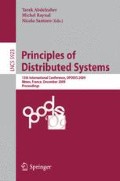Abstract
Short-range wireless communication capabilities enable the creation of ad hoc networks between devices such as smart-phones or sensors, spanning, e.g., an entire high-school or a small university campus. This paper is motivated by the proliferation of devices equipped with multiple such capabilities, e.g., Blue-Tooth (BT) and WiFi for smart-phones, or ZigBee and WiFi for sensors. Yet, each of these interfaces has significantly different, and, to a large extent complementing, characteristics in terms of energy efficiency, transmission range, and bandwidth. Consequently, a viable ad hoc network composed of such devices must be able to utilize the combination of these capabilities in a clever way. For example, BT is an order of magnitude more power efficient than WiFi, but its transmission range is also an order of magnitude shorter. Hence, one would want to shut down as many WiFi transmitters as possible, while still ensuring overall network connectivity. Moreover, for latency and network capacity reasons, in addition to pure connectivity, a desired property of such a solution is to keep the number of BT hops traversed by each transmission below a given threshold k.
This paper addresses this issue by introducing the novel k-Weighted Connected Dominating Set (kWCDS) problem and providing a formal definition for it. A distributed algorithm with a proven approximation ratio is presented, followed by a heuristic protocol. While the heuristic protocol has no formally proven approximation ratio, it behaves better than the first protocol in many practical network densities. Beyond that, a tradeoff between communication overhead and the quality of the resulting kWCDS emerges. The paper includes simulation results that explore the performance of the two protocols.
Access this chapter
Tax calculation will be finalised at checkout
Purchases are for personal use only
Preview
Unable to display preview. Download preview PDF.
References
Bahl, P., Adya, A., Padhye, J., Walman, A.: Reconsidering wireless systems with multiple radios. ACM SIGCOMM Comput. Commun. Rev. 34(5), 39–46 (2004)
Blum, J., Ding, M., Thaeler, A., Cheng, X.: Connected dominating set in sensor networks and MANETs. In: Handbook of Combinatorial Optimization, pp. 329–369 (2005)
Chen, B., Jamieson, K., Balakrishnan, H., Morris, R.: Span: An energy-efficient coordination algorithm for topology maintenance in ad hoc wireless networks. ACM Wireless Networks Journal, 85–96 (2001)
Chen, Y.P., Liestman, A.L.: Approximating minimum size weakly-connected dominating sets for clustering mobile ad hoc networks. In: Proc. ACM MobiHoc, pp. 165–172 (2002)
Chvatal, V.: A greedy heuristic for the set-covering problem. Math. of Operations Research 4(3), 233–235 (1979)
Dubhashi, D., Mei, A., Panconesi, A., Radhakrishnan, J., Srinivasan, A.: Fast distributed algorithms for (weakly) connected dominating sets and linear-size skeletons. J. of Computer and System Sciences 71(4), 467–479 (2005)
Feeney, L.M., Nilsson, M.: Investigating the energy consumption of a wireless network interface in an ad hoc networking environment. In: INFOCOM, pp. 1548–1557 (2001)
Ferro, E., Potorti, F.: Bluetooth and Wi-Fi wireless protocols: a survey and a comparison. IEEE Wireless Communications 12(1), 12–26 (2005)
Gallager, R.G., Humblet, P.A., Spira, P.M.: A distributed algorithm for minimum-weight spanning trees. ACM Trans. Program. Lang. Syst. 5(1), 66–77 (1983)
Gomez, J., Campbell, A.: Variable-range transmission power control in wireless ad hoc networks. IEEE Transactions on Mobile Computing 6(1), 87–99 (2007)
Guha, S., Khuller, S.: Approximation algorithms for connected dominating sets. Algorithmica 20, 374–387 (1998)
Han, B., Jia, W.: Clustering wireless ad hoc networks with weakly connected dominating set. J. Parallel Distrib. Comput. 67(6), 727–737 (2007)
Jia, L., Rajaraman, R., Suel, T.: An efficient distributed algorithm for constructing small dominating sets. In: Proc. ACM PODC, pp. 33–42 (2001)
Kirousis, L.M., Kranakis, E., Krizanc, D., Pelc, A.: Power consumption in packet radio networks. Theoretical Computer Science 243(1-2), 289–305 (2000)
Kuhn, F., Moscibroda, T., Wattenhofer, R.: What cannot be computed locally? In: Proc. ACM PODC, pp. 300–309 (2004)
Kuhn, F., Wattenhofer, R.: Constant-time distributed dominating set approximation. In: Proc. ACM PODC, pp. 25–32 (2003)
Li, L., Halpern, J.Y., Bahl, P., Wang, Y.-M., Wattenhofer, R.: Analysis of a cone-based distributed topology control algorithm for wireless multi-hop networks. In: Proc. ACM PODC, pp. 264–273 (2001)
Pering, T., Agarwal, Y., Gupta, R., Power, C.: Coolspots: Reducing the power consumption of wireless mobile devices with multiple radio interfaces. In: Proc. ACM MOBISYS, pp. 220–232 (2006)
Sinha, P., Sivakumar, R., Bharghavan, V.: Enhancing ad hoc routing with dynamic virtual infrastructures. In: Proc. INFOCOM, pp. 1763–1772 (2001)
Sivakumar, R., Das, B., Bharghavan, V.: Spine routing in ad hoc networks. Cluster Computing 1(2), 237–248 (1998)
Wu, J., Dai, F., Gao, M., Stojmenovic, I.: On calculating power-aware connected dominating sets for efficient routing in ad hoc wireless networks. J. Communications and Networks, 59–70 (2002)
Xu, Y., Heidemann, J., Estrin, D.: Geography-informed energy conservation for ad hoc routing. In: Proc. MOBICOM, pp. 70–84 (2001)
Author information
Authors and Affiliations
Editor information
Editors and Affiliations
Rights and permissions
Copyright information
© 2009 Springer-Verlag Berlin Heidelberg
About this paper
Cite this paper
Friedman, R., Kogan, A. (2009). Efficient Power Utilization in Multi-radio Wireless Ad Hoc Networks. In: Abdelzaher, T., Raynal, M., Santoro, N. (eds) Principles of Distributed Systems. OPODIS 2009. Lecture Notes in Computer Science, vol 5923. Springer, Berlin, Heidelberg. https://doi.org/10.1007/978-3-642-10877-8_14
Download citation
DOI: https://doi.org/10.1007/978-3-642-10877-8_14
Publisher Name: Springer, Berlin, Heidelberg
Print ISBN: 978-3-642-10876-1
Online ISBN: 978-3-642-10877-8
eBook Packages: Computer ScienceComputer Science (R0)

